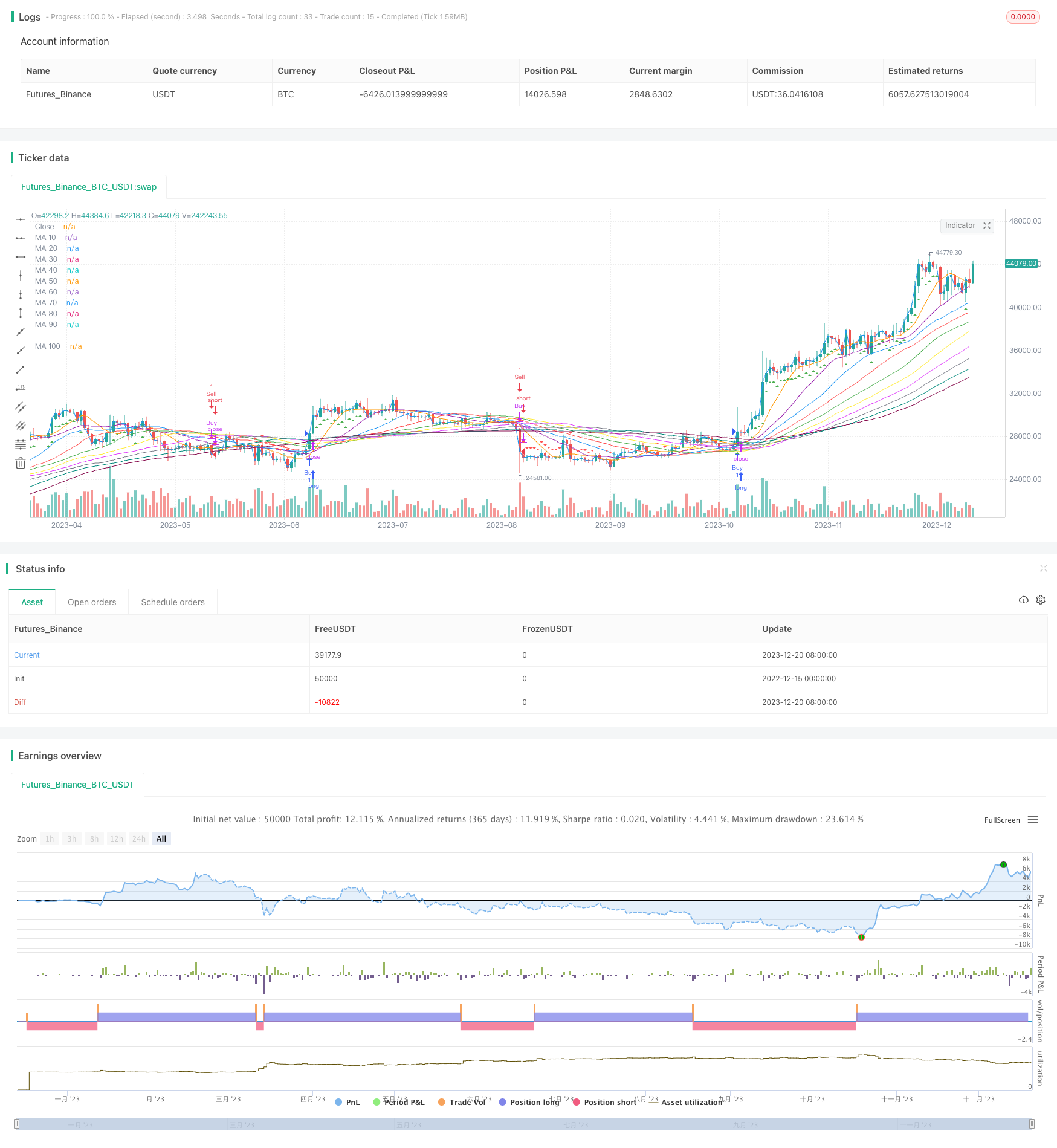
概述
多重移动平均线综合策略是一种非常全面和通用的技术分析策略。它结合了多重时间周期的移动平均线,以提供对市场趋势的全面洞察。该策略通过生成清晰的买入和卖出信号,有助于识别潜在的入场和退出点。它还提供了强大的可定制性,允许用户根据自己的交易偏好和目标调整移动平均线长度。
原理
该策略的核心是计算和跟踪多条不同长度期间的移动平均线,具体包括10日、20日、30日直至100日的移动平均线。这些移动平均线被设定为当天的收盘价与过去一定周期(如10日、20日等)的收盘价的平均值。例如20日移动平均线是过去20日收盘价的平均值。
当今天的收盘价高于所有这些移动平均线时,产生买入信号。当今天的收盘价低于所有这些移动平均线时,产生卖出信号。这样,只有当所有周期的移动平均线都指向同一个方向时,才会产生信号,从而过滤了很多噪音交易机会,使得信号更加可靠。
优势
提供多时间尺度的洞察,能够适应不同的市场环境
通过多个确认,过滤 Noise,信号较为可靠
交易规则清晰,易于理解和实施
具备高度的自定义性,用户可以调整参数满足个性化需求
为入场、止损、止盈提供明确的指引,有助于风险管理
风险及解决方法
当市场处于震荡期时,多个移动平均线可能互相交叉,导致无明确信号产生。可通过调整移动平均线周期数量和长度来降低交叉概率。
未来期价格突破多个移动平均线的可能性较低,可能错过部分交易机会。可适当减少移动平均线数量,降低突破难度。
信号产生滞后,无法在价格转折点前捕捉趋势。结合其他先行指标如MACD可提高对趋势转折的判断。
交易次数可能不多,难以获得稳定收益。可以适当缩短移动平均线长度或与其他策略/指标组合使用。
优化方向
参数调整:调整移动平均线周期数及长度,寻找最佳参数组合。例如可测试5日、10日和20日移动平均线的组合。
结合其他指标:与MACD、RSI等其他指标组合使用,提高策略的韧性。不同指标可实现互补。
策略组合:与其他策略如突破系统、趋势跟踪系统组合,提高稳定性。不同策略可分散风险。
自动寻优:采用算法自动测试不同参数,寻找期望最大化的参数组合。降低人工干预,提高效率。
总结
多重移动平均线综合策略是一种非常全面和强大的策略工具。它提供多时间尺度洞察,信号较为可靠,易于理解使用,并具备高度自定义性。同时也存在一定局限性,但可通过调整参数、与其他模型组合等方式获得优化,从而适应更加复杂的市场情况。该策略既可作为学习工具辅助技术分析思维建立,也可供实盘交易使用。用户可根据自身需要进行调整,将其专属化。
/*backtest
start: 2022-12-15 00:00:00
end: 2023-12-21 00:00:00
period: 1d
basePeriod: 1h
exchanges: [{"eid":"Futures_Binance","currency":"BTC_USDT"}]
*/
//@version=5
strategy("Multiple Moving Average Strategy", overlay=true)
// Function to calculate moving average
get_ma(src, length) =>
ta.sma(src, length)
// Initialize moving average lengths
ma_length_10 = 10
ma_length_20 = 20
ma_length_30 = 30
ma_length_40 = 40
ma_length_50 = 50
ma_length_60 = 60
ma_length_70 = 70
ma_length_80 = 80
ma_length_90 = 90
ma_length_100 = 100
// Calculate 10-day, 20-day, 30-day, 40-day, 50-day, 60-day, 70-day, 80-day, 90-day, and 100-day moving averages
ma_10 = get_ma(close, ma_length_10)
ma_20 = get_ma(close, ma_length_20)
ma_30 = get_ma(close, ma_length_30)
ma_40 = get_ma(close, ma_length_40)
ma_50 = get_ma(close, ma_length_50)
ma_60 = get_ma(close, ma_length_60)
ma_70 = get_ma(close, ma_length_70)
ma_80 = get_ma(close, ma_length_80)
ma_90 = get_ma(close, ma_length_90)
ma_100 = get_ma(close, ma_length_100)
// Generate Buy/Sell signals for the 10 moving averages
buy_signal = close > ma_10
sell_signal = close < ma_10
// Add conditions for each additional moving average length
buy_signal := buy_signal and (close > get_ma(close, ma_length_20))
sell_signal := sell_signal and (close < get_ma(close, ma_length_20))
buy_signal := buy_signal and (close > get_ma(close, ma_length_30))
sell_signal := sell_signal and (close < get_ma(close, ma_length_30))
buy_signal := buy_signal and (close > get_ma(close, ma_length_40))
sell_signal := sell_signal and (close < get_ma(close, ma_length_40))
buy_signal := buy_signal and (close > get_ma(close, ma_length_50))
sell_signal := sell_signal and (close < get_ma(close, ma_length_50))
buy_signal := buy_signal and (close > get_ma(close, ma_length_60))
sell_signal := sell_signal and (close < get_ma(close, ma_length_60))
buy_signal := buy_signal and (close > get_ma(close, ma_length_70))
sell_signal := sell_signal and (close < get_ma(close, ma_length_70))
buy_signal := buy_signal and (close > get_ma(close, ma_length_80))
sell_signal := sell_signal and (close < get_ma(close, ma_length_80))
buy_signal := buy_signal and (close > get_ma(close, ma_length_90))
sell_signal := sell_signal and (close < get_ma(close, ma_length_90))
buy_signal := buy_signal and (close > get_ma(close, ma_length_100))
sell_signal := sell_signal and (close < get_ma(close, ma_length_100))
// Plot Buy/Sell signals on the chart
plotshape(buy_signal, title="Buy Signal", color=color.green, style=shape.triangleup, location=location.belowbar)
plotshape(sell_signal, title="Sell Signal", color=color.red, style=shape.triangledown, location=location.abovebar)
// Execute long buy order when all ten moving averages give a Buy signal
if (buy_signal)
strategy.entry("Buy", strategy.long)
// Execute sell order when all ten moving averages give a Sell signal
if (sell_signal)
strategy.close("Buy")
// Execute short sell order when all ten moving averages give a Sell signal
if (sell_signal)
strategy.entry("Sell", strategy.short)
// Execute buy order when all ten moving averages give a Buy signal
if (buy_signal)
strategy.close("Sell")
// Plot closing price and moving averages on the chart
plot(close, title="Close", color=color.blue)
plot(ma_10, title="MA 10", color=color.orange)
plot(ma_20, title="MA 20", color=color.purple)
plot(ma_30, title="MA 30", color=color.blue)
plot(ma_40, title="MA 40", color=color.red)
plot(ma_50, title="MA 50", color=color.green)
plot(ma_60, title="MA 60", color=color.yellow)
plot(ma_70, title="MA 70", color=color.fuchsia)
plot(ma_80, title="MA 80", color=color.gray)
plot(ma_90, title="MA 90", color=color.teal)
plot(ma_100, title="MA 100", color=color.maroon)